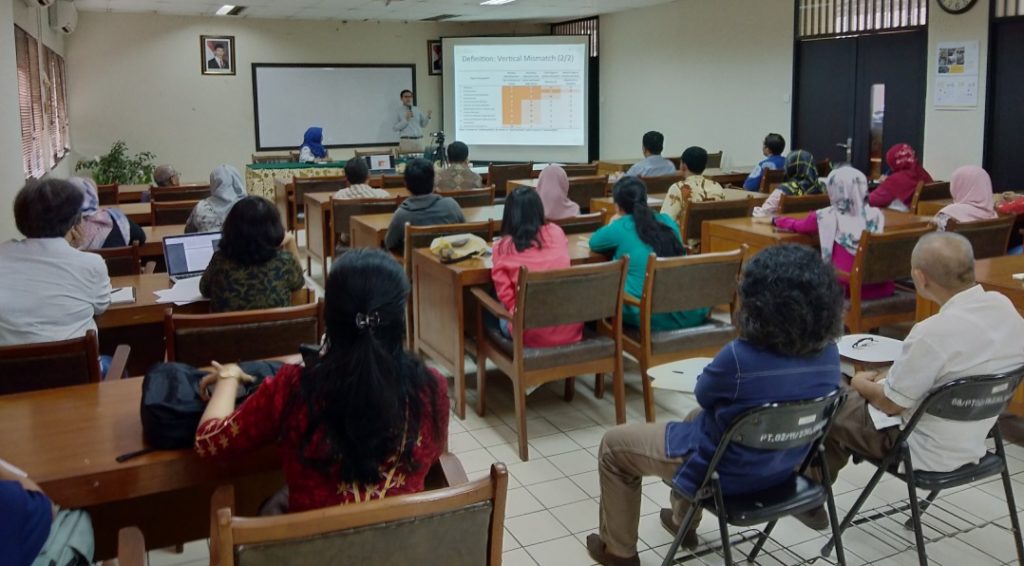On 24 May 2018, Lembaga Demografi, Faculty of Economics and Business Universitas Indonesia (LD FEB UI) hosted the FKP seminar in Depok on the topic of job mismatch incidence in Indonesia and its impact on earnings by Rachmat Reksa Samoedra (LD FEB UI).
Previous studies on job mismatch incidence have been done only in developed countries (OECD members). Therefore, the objective of the study was to give evidence from Indonesia as developing country about the types of incidence, specifically vertical mismatch (comparing required years of schooling (YOS) for the job with worker’s actual years of schooling) and horizontal mismatch (comparing required educational major for the job with worker’s actual educational major).
The study defined years of schooling as an indicator for vertical mismatch into three categories: (i) underqualified (actual YOS< required YOS), (ii) well-matched (actual YOS = required YOS), and (iii) overqualified (actual YOS > required YOS). Horizontal mismatch was classified into three categories as well: (i) mismatch (different actual and required education background), (ii) somewhat match (education required for the job can be filled with any education background), and (iii) match (same actual and required education background). Mismatch incidence was counted from people having a condition with (i) and (ii). The study used Survey Tenaga Kerja (Sakernas) 2008 and 2015, where samples were restricted to employed, aged 18-64 years old, higher educational background, and excluding army forces and police. The study used descriptive analysis to show job mismatch incidence and using regression analysis to show wage penalty resulted from the incidence.
Reksa Samoedra presented his study on LD FEB UI
The study results in some fruitful findings. Overall, the study showed some hints about labor market equilibrium in Indonesia, especially labor allocation. On vertical mismatch, although the incidence has been decreasing over time, there are still 47.74% workers categorized as overqualified. These people were mostly found in the agriculture sector, whereas service sectors were mostly filled with well-matched workers. The study also found that young workers will become overqualified workers, but eventually become well-matched workers due to career advancement overtime and higher labor supply growth compared to labor demand growth for higher education workers. On horizontal mismatch, the study found 60% mismatch workers throughout 2008 and 2015. These people were also found in the agriculture sector, whereas matched workers were also filled in service sectors. Through age-profiling perspective, as workers get longer participated in the workforce were likely to find an identical job with their education major.
The researcher also measured wage bonus (penalty) occurred from mismatch incidence. Some findings are as follow. First, a vertically mismatched worker will likely to gain around 8-12% wage penalty in 2008 and 2-7% penalty in 2015. However, trained-but-vertically-mismatched workers, will likely to earn bonus as much as 0-3% in 2008 and 20-26% in 2015. The wage penalty was persistent across age-profile, yet the magnitude for overqualified workers was converged towards well-matched over seven years. In addition, wage penalty for horizontally mismatched workers was also persistent and converged towards matched in 2015.
The overall results have given some implications. First, the economy should create a more inclusive labor demand situation by increasing need for workers with higher education level and linking needs of companies with programs in higher education that acted as labor supply. Second, it is beneficial to provide training for mismatched workers so that the wage penalty effects could be softened. Third, higher education curriculum should be adjusted routinely with current and future labor market demand. Lastly, it is also beneficial to reduce asymmetric information between workers and firms, perhaps through more career expos.
For the complete presentation and Q&A session, please refer to the videos and materials provided.





